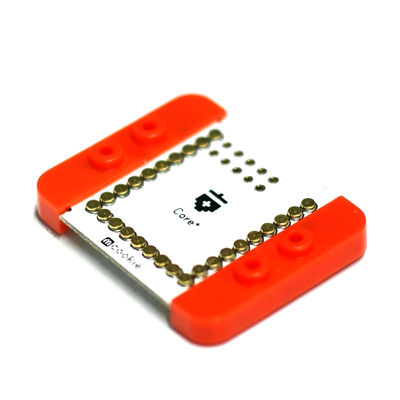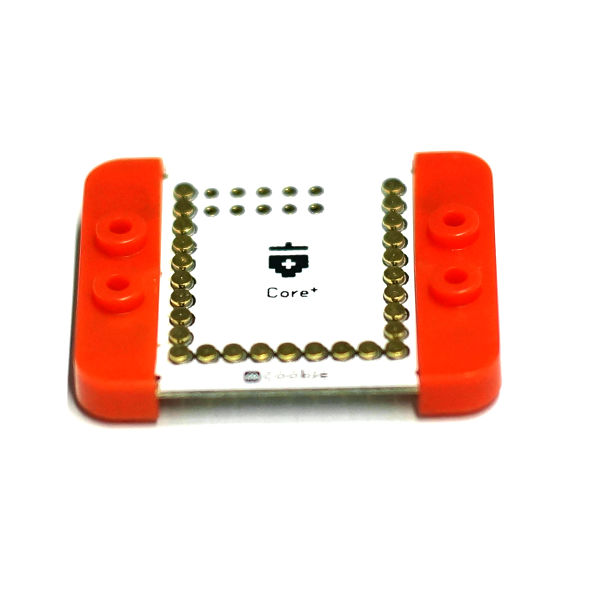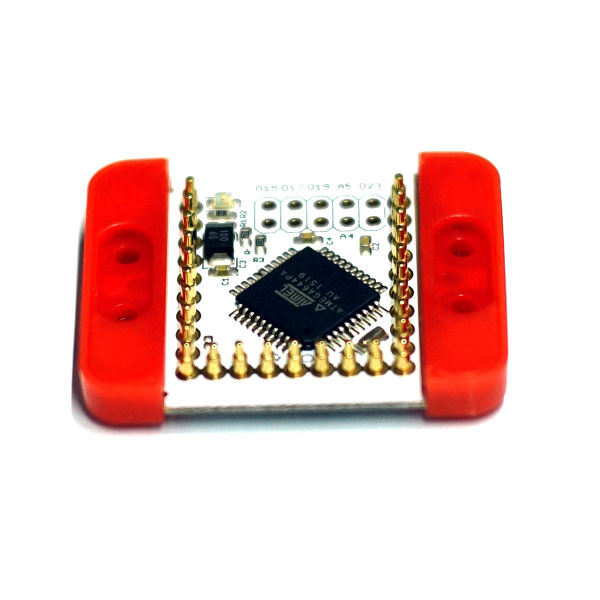|
|
| Line 188: |
Line 188: |
| | * 1.To download programs to mCookie-Core+, players need to use '''[[mCookie-USBTTL]]''' module. | | * 1.To download programs to mCookie-Core+, players need to use '''[[mCookie-USBTTL]]''' module. |
| | * 2.The tutorial of setting development environment and installing the driver is as following: | | * 2.The tutorial of setting development environment and installing the driver is as following: |
| − | **'''[[mCookie-CoreUSB Getting started]]''' | + | **'''[[MCookie_Tutorials_and_Projects|Getting Started Guide and Tutorials]]''' |
| | | | |
| | | | |
| | |- | | |- |
| | | | | | |
| | + | |
| | ==Application== | | ==Application== |
| | [[MCookie_(Microduino compatible board)tutorial]] | | [[MCookie_(Microduino compatible board)tutorial]] |
|
mCookie-Core+ is a 8-bit microcontroller development board with Atmel ATmega1284P and ATmega644PA serials as the core. And it is an open-source and compatible-with-mCookie-Core+ controller module.
Besides the features of mCookie-Core, the inputting and outputting number of Flash, RAM and EEPROM of mCookie-Core+ have been greatly improved. Pins meet the mCookie specification, and players can upgrade Core smoothly to Core+, without modifying arduino codes.
mCookie use the same java and C language development environment with Arduino. Players can use Arduino IDE, coordinated with software such as Flash or Processing, with mCookie and other electronic components, modules, and sensors, to make many interesting interactive works.
Features
- Strong configuration. It has 128KB Flash and 16KB SRAM, as biggest as possible.
- Small, cheap, stackable and open;
- Open-source hardware circuit design and compatible-with-Arduino programming development environment;
- Unified mCookie interface specification and abundant peripheral module, which make it can be extended and connected with other modules and sensors which meet the Microduino/mCookie interface specification;
|
Specification
- There are 4 versions of mCookie-Core+, according to different cores and clock frequency:
| MCU type
|
Flash
|
SRAM
|
EEPROM
|
Clock Frequency
|
Working voltage
|
| ATmega644PA
|
64K
|
4K
|
2K
|
16M
|
5.0V
|
| ATmega644PA
|
64K
|
4K
|
2K
|
8M
|
3.3V
|
| Atmega1284P
|
128K
|
16K
|
4K
|
16M
|
5.0V
|
| ATmega1284P
|
128K
|
16K
|
4K
|
8M
|
3.3V
|
- There are 32 Digital I/O :
- On the module labeled D0, D1, D2~D13 and A0~A7, and the ten(D14~D23) more than core.
- There are 8 Analog I/O :
- On the module labeled A0~A7;
- Each provides 10 resolution ratio(that is 0~1024). By default, the measurement range of the analog voltage is the value from GND to VCC;
- Please refer to analogRead()function for details.
- There are 8 PWM supporters:
- On the module labeled D7, D8, D9, D10, D12, D13, D22, and D23 respectively.
- Please refer to analogWrite() function for details.
- There are two serial port supporters:
- On the module labeled Serial[D0(RX), D1(TX)] and Serial1[D2(RX), D3(TX)].
- Connected with USBTTL module will occupy D0 and D1. If ports D0 and D1 are also occupied by other modules, the communication with USBTTL will be abnormal, and the program will be unable to be downloaded.
- There is one SPI supporter:
- On the module labeled D13(SCK), D12(MISO), D11(MOSI), and D10(SS).
- There is one I2C supporter:
- On the module labeled SDA(D20), SCL(D21).
- There are 3 external interrupt supporters:
- On the module labeled D2(interrupt0), D3(interrupt1), and D6(interrupt2).
- Please refer to attachInterrupt() function for details.
- Support ISP download function.
- Support AREF end.
| Pin
|
Original Pin Name
|
Map Pin Name
|
Digital Pin
|
Analog Pin
|
interrupt
|
PWM
|
Serial
|
SPI
|
I2C
|
Power
|
| 1 |
VCC |
+5V |
|
|
|
|
|
|
|
+5V
|
| 2 |
VCC |
+3V3 |
|
|
|
|
|
|
|
+3.3V
|
| 3 |
(OC0A/AIN1)PB3 |
D7 |
D7 |
|
|
yes |
|
|
|
|
| 4 |
(OC2B/ICP)PD6 |
D8 |
D8 |
|
|
yes |
|
|
|
|
| 5 |
(OC1A)PD5 |
D9 |
D9 |
|
|
yes |
|
|
|
|
| 6 |
(OC0B/SS)PB4 |
D10 |
D10 |
|
|
yes |
|
SS |
|
|
| 7 |
(MOSI)PB5 |
D11 |
D11 |
|
|
|
|
MOSI |
|
|
| 8 |
(MISO)PB6 |
D12 |
D12 |
|
|
|
|
MISO |
|
|
| 9 |
(SCK)PB7 |
D13 |
D13 |
|
|
|
|
SCK |
|
|
| 10 |
AREF |
AREF |
|
|
|
|
|
|
|
|
| 11 |
(ADC7)PA7 |
A0 |
D24 |
A0 |
|
|
|
|
|
|
| 12 |
(ADC6)PA6 |
A1 |
D25 |
A1 |
|
|
|
|
|
|
| 13 |
(ADC5)PA5 |
A2 |
D26 |
A2 |
|
|
|
|
|
|
| 14 |
(ADC4)PA4 |
A3 |
D27 |
A3 |
|
|
|
|
|
|
| 15 |
(SDA)PC1 |
SDA |
D20 |
|
|
|
|
|
SDA |
|
| 16 |
(SCL)PC0 |
SCL |
D21 |
|
|
|
|
|
SCL |
|
| 17 |
(ADC1)PA1 |
A6 |
D30 |
A6 |
|
|
|
|
|
|
| 18 |
(ADC0)PA0 |
A7 |
D31 |
A7 |
|
|
|
|
|
|
| 19 |
(RXD0)PD0 |
D0 |
D0 |
|
|
|
0(RX) |
|
|
|
| 20 |
(TXD0)PD1 |
D1 |
D1 |
|
|
|
0(TX) |
|
|
|
| 21 |
(INT0)PD2 |
D2 |
D2 |
|
0 |
|
1(RX) |
|
|
|
| 22 |
(INT1)PD3 |
D3 |
D3 |
|
1 |
|
1(TX) |
|
|
|
| 23 |
(XCK0/T0)PB0 |
D4 |
D4 |
|
|
|
|
|
|
|
| 24 |
(CLKO/T1)PB1 |
D5 |
D5 |
|
|
|
|
|
|
|
| 25 |
(INT2/AIN0)PB2 |
D6 |
D6 |
|
2 |
|
|
|
|
|
| 26 |
RESET |
RST |
|
|
|
|
|
|
|
|
| 27 |
GND |
GND |
|
|
|
|
|
|
|
GND
|
| 28 |
(TOSC2)PC7 |
D14 |
D14 |
|
|
|
|
|
|
|
| 29 |
(TOSC1)PC6 |
D15 |
D15 |
|
|
|
|
|
|
|
| 30 |
(TDI)PC5 |
D16 |
D16 |
|
|
|
|
|
|
|
| 31 |
(TDO)PC4 |
D17 |
D17 |
|
|
|
|
|
|
|
| 32 |
(TMS)PC3 |
D18 |
D18 |
|
|
|
|
|
|
|
| 33 |
(TCK)PC2 |
D19 |
D19 |
|
|
|
|
|
|
|
| 34 |
(ADC3)PA3 |
A4 |
D28 |
A4 |
|
|
|
|
|
|
| 35 |
(ADC2)PA2 |
A5 |
D29 |
A5 |
|
|
|
|
|
|
| 36 |
(OC1B)PD4 |
D22 |
D22 |
|
|
yes |
|
|
|
|
| 37 |
(OC2A)PD7 |
D23 |
D23 |
|
|
yes |
|
|
|
|
|
Documents
- The main components used in mCookie-Core+
|
Development
- 1.To download programs to mCookie-Core+, players need to use mCookie-USBTTL module.
- 2.The tutorial of setting development environment and installing the driver is as following:
|
Application
MCookie_(Microduino compatible board)tutorial
FAQ
- Q: How to judge whether the voltage of the Core+ in my hand is 3.3V or 5V?
- A: You can judge it from the resistance. If R1 is welded, it is 3.3V. And if R2 is welded, it is 5V.
- Q: Can I use 3.3V electricity to supply power to Core+, of which the clock frequency is 16M?
- A: It is not recommended. If the voltage is too low, it will be unstable.
- Q: Can I use 5V electricity to supply power to Core+, of which the clock frequency is 8M?
Purchase
Gallery
|
History
|


